|
Boletín de la Sociedad Geológica Mexicana Volumen 75, núm. 3, A220623, 2023 http://dx.doi.org/10.18268/BSGM2023v75n3a220623
|
 |
Invertebrate fauna of the Albian–Lower Cenomanian deposits in the Fars and Isfahan provinces (Firuzabad and Fasakhod sections), Zagros Basin, Central Iran
Fauna de invertebrados de los depósitos del Albiano-Cenomaniano Inferior en las provincias de Fars e Isfahan (secciones Firuzabad y Fasakhod), Cuenca de Zagros, Irán Central
Babak Sedghi1, Ali Bahrami1,*, Mehdi Yazdi1, Francisco J. Vega2
1 Department of Geology, Faculty of Sciences, University of Isfahan, 81746-73441, Isfahan, I.R. Iran.
2 Instituto de Geología, Universidad Nacional Autónoma de México, Ciudad Universitaria, Coyoacán, 04510, CDMX, Mexico.
* Corresponding author: (A. Bahrami) This email address is being protected from spambots. You need JavaScript enabled to view it.
How to cite this article:
Sedghi, B., Bahrami, A., Yazdi, M., Vega, F.J., 2023, Invertebrate fauna of the Albian–lower Cenomanian deposits in the Fars and Isfahan provinces (Firuzabad and Fasakhod sections), Zagros Basin, Central Iran: Boletín de la Sociedad Geológica Mexicana, 75 (3), A220623. http://dx.doi.org/10.18268/BSGM2023v75n3a220623
Manuscript received: May 8, 2023; Corrected manuscript received: June 19, 2023; Manuscript accepted: June 21, 2023.
ABSTRACT
The Albian- Cenomanian deposits of the Kazhdumi Formation at Zagros Basin (Firuzabad section and Central Iran (Fasakhod section), represents a carbonate sedimentary succession and contain rich and diverse invertebrate macro fauna. Detailed studies on about 200 specimens of invertebrate macro fauna revealed from two stratigraphic intervals led to recognition of 5 species of gastropods; (Liopeplum? sp., Columbellina sp., Cryptaulax? sp., Turritella? sp., Pleurotomaria sp.), 3 species of ammonites; (Knemiceras duberterti, Sphenodiscus sp., Knemiceras persicum), 10 species of bivalves assemblages; (Ceratostreon flabellatum, Cardium? sp., Exogyra (Costagyra) olisiponensis, Neithea (Neithea) quinquecostata, Trigonia sp., Buchia? sp., Cardium? sp., Pseudogyra sp., Ontaria? sp., Nucula? sp., Pleuromia? sp., 1 species of echinoids; Dorocidaris taouzensis with a prolific horizon of Notopocorystes xizangensis of raninoid crabs. The absence of large gastropods and bivalves fauna and abundance of suspension-feeders indicated instability of the substrate, shallow marine paleoenvironment.and a medium energy condition.
Keywords: Cretaceous, Albian-Cenomanian, Kazhdumi Formation, fossil content, Iran.
RESUMEN
Texto Los depósitos del Albiano-Cenomaniano de la Formación en la Cuenca de Zagros (sección Firuzabad e Irán Central (sección Fasakhod), representan una sucesión carbonatada sedimentaria que contiene una diversa y rica macrofauna de invertebrados. Estudios detallados de 200 muestras de macrofauna de invertebrados, colectados en dos intervalos estratigrádicos , llevaron al reconocimiento de 5 especies de gasterópodos; (Liopeplum? sp., Columbellina sp., Cryptaulax? sp., Turritella? sp., Pleurotomaria sp.), 3 especies de ammonites; (Knemiceras duberterti, Sphenodiscus sp., Knemiceras persicum), 10 especies de composiciones de bivalvos (Ceratostreon flabellatum, Cardium? sp., Exogyra (Costagyra) olisiponensis, Neithea (Neithea) quinquecostata, Trigonia sp., Buchia? sp., Cardium? sp., Pseudogyra sp., Ontaria? sp., Nucula? sp., Pleuromia? sp., una especies de echinoideo; Dorocidaris taouzensis, con un prolífico horizonte de cangrejos raninoides Notopocorystes xizangensis. La ausencias de gandes gasterópodos y bivalvos y la abundancia de alimentadores por suspensión, indican inestabilidad del substrato, un paleoambiente marino somero y condiciones de energía media.
Palabras clave: Cretácico, Albiano-Cenomaniano, Formación Kazhdumi, contenido fósil, Irán.
- Introduction
The Iranian Plate, a major segment of the Cimmerian micro-continent, had detached from northeastern Gondwana by the end of Permian and collided with the Turan Plate (part of Eurasia) towards the end of the Triassic (Sengore, 1990; Stampfli et al., 1991; Saidi et al., 1997; Mirnejad et al., 2013). From the Early Jurassic to Senonian, the young Neo-Tethyan oceanic basin was reduced in extent by its subduction under the Iranian continental plate. The final closure of the Neo-Tethys, marked by the collision between the Iranian and Arabian plates, took place during the Neogene (Berberian et al., 1982; Shahabpour, 2005; Ahmadi-Khalaji et al., 2007). The Iranian plateau is divided into several zones from SW to NE (Figure 1): Zagros fold-thrust belt, Sanandaj-Sirjan metamorphic zone, Urumieh-Dokhtar volcanic belt, central Iran zone, Alborz zone, Kopeh Dagh zone, and Eastern Iran zone (Falcon, 1967; Stocklin, 1968; Dewey et al., 1973; Stocklin and Nabavi, 1973; Jackson and McKenzie, 1984; Sengore, 1984; Byrne et al., 1992; McCall, 2002; Blanc et al., 2003; Alavi, 2004; Walker and Jackson, 2004; Barber et al., 2018; Ghorbani, 2019; Ghassemi et al., 2023). Among rock units studied in the Zagros basin, the Kazhdumi Formation (Albian-lower Cenomanian) is significant for its characteristics as a petroleum source rock, being part of the Bangestan Group which consists of the Kazhdumi, Sarvak, Surgah, and Ilam formations. In general, the lithological aspect of the Kazhdumi Formation is comprised of dark bituminous shale, fossiliferous marl and limestone intercalations (James and Wynd, 1965; Afghah et al., 2007; Soleimani, 2009). The surrounding strata, Dariyan (Aptian) is the underlying formation, while Sarvak is known as the overlying formation (upper Cenomanian) (Afghah et al., 2020; Arampour et al., 2021). These strata are well exposed in many parts along the Zagros mountain ranges (Figure 2).
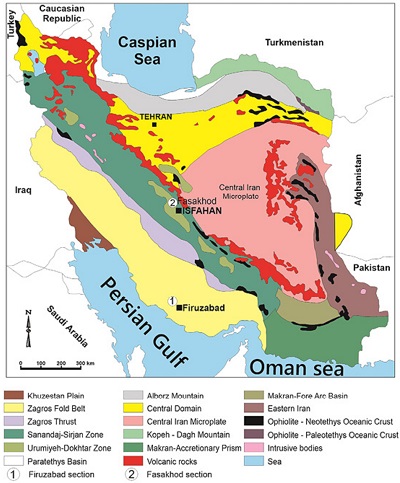 |
| Figure 1. Structural and sedimentary zones of Iran (after Sahandi et al., 2002; Richards et al. 2006). |
 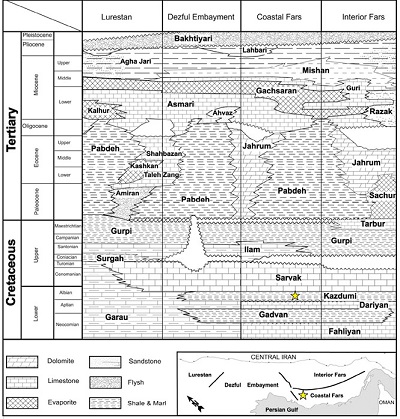 |
| Figure 2. Expansion and stratigraphic correlation chart of Iranian sector of the Zagros (adapted from James and Wynd, 1965; Motiei, 1993). |
The lithostratigraphic contact between the Dariyan and Kazhdumi formations is marked by an oxidized iron nodule zone (James and Wynd, 1965; Motiei, 1992; Afghah and Shabanpour Haghighi, 2014; Soleimani et al., 2014). The Sarvak Formation (gray well-bedded limestone) covers the marl of Kazhdumi Formation. Sarvak Formation reveals various lower biostratigraphic limits covering the continuous sedimentation of the Kazhdumi and Sarvak formations during the Albian-Cenomanian. Kalantari (1976) studied the Kazhdumi marls in the southeastern Shiraz with continuous sedimentation between the Dariyan and the Kazhdumi formations.
In Central Iran domain (Isfahan province), following the late Cimmerian orogeny, the Early Cretaceous sea advanced onto the small continent of Central Iran. The transgression began in the late Barremian and continued to the early Albian. A sequence of thick sediments eroded by this uplift included several lithologies such as red conglomerate, sandstones and limestones, Orbitolina gray limestones with marl intercalations into the late Aptian. Shales with intercalations of limestone contain ammonites and green to gray marly limestone with small turritellid gastropods, bivalves, ammonites can be found throughout the unit which indicate an Albian age for this sequence (Seyedemami et al., 1971; Kalantari, 1981; Amirshahkarami, 1998; Amirshahkarami and Vaziri-Moghadam, 2000; Salehi and Tadayon, 2019). Thick, micritic Cenomanian-Turonian limestones unconformable overlie the Albian deposits.
The present contribution indicates invertebrate macro fauna of the Albian-lower Cenomanian deposits of south and central Iran to better interpret the depositional condition during the time interval.
- Geological setting
2.1. FIRUZABAD SECTION
The Firuzabad section is located 45 km southwest of Firuzabad city in Fars province, southwest Iran. The geographic coordinates for the base are E: 52°24′ 35′′, N: 28° 35′ 49′′ and the top of the section E: 52°24′ 32′′, N: 28° 35′ 59′′, with 2423 m above the sea level. The studied section is part of the southern flank of the Khartu anticline with a northwest-southeast trend and somehow crushed between the kuh-e-Gach and kuh-e-Jehani Salt domes of the late Precambrian-Cambrian Hormoz Series (Figure 3).
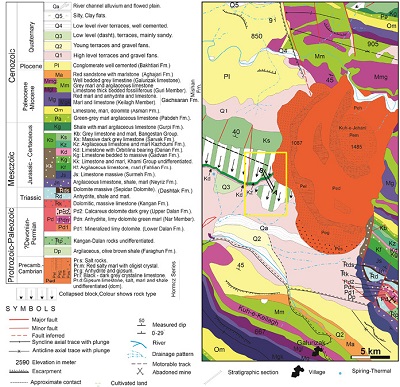 |
| Figure 3. Simplified geological map of the Khartu anticline and Kuk-e-Jehani Salt Dome, showing the location of the study exposure (adapted from Sedaghat and Dabaghian Nejad, 1996, Farrashband Geological map, Series Sheet No 6447). |
The studied Cretaceous interval outcrop is assigned to Aptian through Cenomanian successions (Dariyan, Kazhdumi and Sarvak formations). The Dariyan Formation (Aptian) is well exposed and mainly composed of gray thick bedded to massive orbitolinid sandy limestone. The Kazhdumi shale, marl and marly limestone formation covers the Dariyan Formation and the white gray massive limestone of the Sarvak Formation (Cenomanian), which overlies the Kazhdumi Formation as a gradational contact.
The thickness of the studied deposits of the Kazhdumi Formation is approximately 60 m. From top to bottom, the succession is as follows (Figure 4):
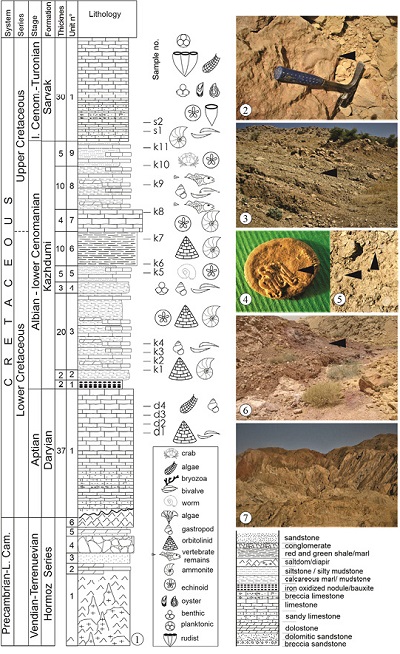 |
| Figure 4. (1) Lithostratigraphical column of the studied exposure of the Firuzabad section showing the distribution of the main collected macrofossils and the assigned levels, (2) black arrow shows the rudist fragments of the Sarvak Formation, 3- panoramic view of the Kazhdumi Formation in the studied exposure with indication to the fossiliferous horizons, 4- isolated orbitolinid from the marls of the unit 5 with encrusted tube worms, 5- isolated orbitolinids from the unit 6, 6- iron oxidized nodule (unit 1) at the base of the Kazhdumi Formation in contact to the underlying Darian Formation, and 7- panoramic view of the Kuh-e-Jehani Salt Dom of the Precambrian-Cambrian Hormoz Series. |
Top - white gray massive sandy nodular limestone containing crushed rudists fragments (Sarvak Formation).
- Alternation of cream to light brown limestone and red marls with very tiny sandstone sub minors including scattered ammonites, bivalves and echinoderms (5 m).
- Alternation of green marls with loose clay and thin bedded limestone rich in vertebrate micro-remains, crustacean remains, as well as gastropods and bivalves (7-10 m).
- Alternation of brown marl with thin bedded limestone including large scale echinoids and ammonites (4-5 m).
- Red muddy clay and marls with scattered ammonites and isolated orbitolinids(10 m).
- Alternation of thin bedded argillaceous limestone with olive-green marls including isolated orbitolinids and tube worms (5 m).
- Yellow marls rich in macro-fauna: bivalves, echinoids and gastropods (3 m).
- Cream to light thin bedded limestone and marly limestone (20 m).
- Alternation of yellow muddy bituminous clay and marls with orbitolinids (2 m).
- Oxidized iron nodule and bauxitic levels (1.5-2 m).
Base: Cream to light medium to thick bedded limestone, breccia limestone and sandy limestone (Darian Formation).
2.2. FASAKHOD SECTION
The most complete Cretaceous sections in Central Iran domain are found in the Isfahan province. The rocks consist of marine shale, marl, limestone and sandstone, reaches a thickness of more than 800 m and seems to represent all major parts of the Lower to Upper Cretaceous strata (Seyedemami et al., 1971; Mannani and Yazdi, 2009; Salehi and Tadayon, 2019). However, the marine sequences are frequently interrupted by conglomerates, red beds, sedimentary gaps and unconformities and the sections vary in detail over short distances, reflecting the unstable conditions of the sedimentary environment during the initial phases of the Alpine orogeny. This and considerable disagreement between interpretations of different authors regarding the stratigraphic significance of the faunas, has so far made reliable correlation over any greater distance difficult and a consistent stratigraphic subdivision of the Cretaceous has yet to be established. The Stratigraphic Terminological Committee (STC) of Iran has recommended not introducing any formal stratigraphic names for the Cretaceous strata of the Central Iran until more regional information becomes available to clarify the situation, in compliance with this recommendation (Stocklin and Setudehnia, 1991; Ghasemi and Talbot, 2006). The Fasakhod section is situated in the NW-SE striking at approximately 5 km southeast of Fasakhod village (Ardestan area, 75 km north Isfahan city), and is accessible by the Isfahan-Ardestan road (Figure 5). The section is 210 m thick and is composed of 7 lithological associations, marls and limestones, which were deposited alternatively (Figure 5). The section from the lower to the upper part is as follows:
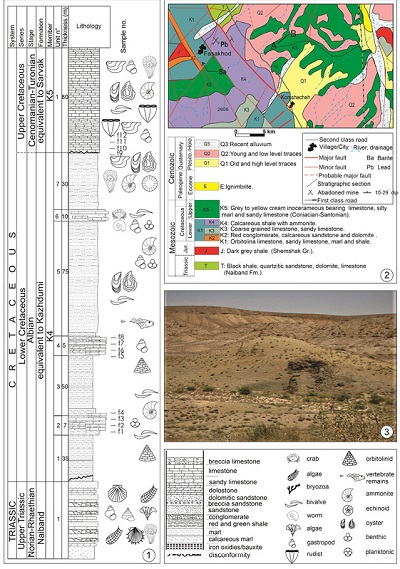 |
| Figure 5. (1) lithostratigraphical column of the studied exposure of the Fasakhod section showing the distribution of the main collected macrofossils and the assigned levels, (2) simplified geological map of the Fasakhod area showing the location of the study exposure (adapted from Radfar, 1998, Geological map of Ardestan 1:100000, (3) panoramic view of the studied section, lower part indicates the Albian green shales and the upper cliff-making Cenomanian-Turonian limestone. |
Top: massive cliff making limestone (Cenomanian-Turonian; equivalent to Sarvak Formation).
- Shale and light green marl with gastropods, bivalves, scattered solitary corals, ammonites (30 m).
- Gray, thin-bedded sandy limestone with gastropods, bivalves tube worms, crustacean remains (10 m).
- Light green marls with ammonites and shell fragments (75 m).
- Gray sandy limestone with intercalation of marls including scattered ammonites and shell fragments (5 m).
- Green to olive marl (50 m).
- Brown sandy limestone (7 m).
- Green marls (35 m).
- Angular unconformity.
- Purple to brown sandstone, conglomerate, dolomitic limestone and shale, with thin bedded limestone including plants remains, bivalves, colonial and solitary corals, gastropods (Upper Triassic Naiband Formation).
- Materials and methods
Two well-exposed stratigraphic sections of the Cretaceous deposits (Kazhdumi Formation and its lithologic equivalents) in southwest and central Iran were selected in order to study the frame of the biostratigraphy and fossil fauna. The lower and upper lithostratigraphic limits were determined by detailed field observations. In addition, the material includes a large proportion of crushed, distorted, imperfect, or weathered individuals. Well-preserved specimens were cleaned by means of a mild detergent, and whenever necessary, an ultrasonic vibrator and a preparation needle. Finally, a light bionocular microscope was used, where it was necessary. 35 samples were collected from the studied profile in Fashakhod section (12 rock samples and 23 washing samples), 170 m from the base of the profile there is 10 m of thin bedded limestone prolific in crustacean remains here reported. From the deposits of the Kazhdumi Formation at Firuzabad section, 17 rock samples and about 200 individual fossils (gastropods, ammonites, bivalves, crustaceans and echinoids) with morphological structures preserved were collected and prepared for further studies. At 27 m from the base of the studied exposure at Firuzabad section there is also a level of small crustaceans, with abundant microscopic crushed fragments of carapace and claws. All the studied samples are housed in the Department of Geology, Faculty of Sciences, University of Isfahan under the IUMC.
- Invertebrate fauna
4.1. MOLLUSKS
The gastropods are represented mainly by internal molds (Figure 6.1-6.10), and thus their taxonomic position is hard to precise: Liopeplum? sp. (Figure 6.1, 6.2), Columbellina sp. (Figure 6.3-6.5), Cryptaulax? sp. (Figure 6.6, 6.7), Turritella? sp. (Figure 6.8), Pleurotomaria sp. (6.9, 6.10). Although incomplete, some specimens of ammonites were able to be identified as Knemiceras duberterti Basse, 1940 (Figure 6.11), Sphenodiscus sp. (Figure 6.12), K. persicum Collignon, 1983 (Figure 6.13-6.16). The bivalves include Ceratostreon flabellatum (Figure 7.1-7.3, 7.5, 7.6), Cardium? sp. (Figure 7.4), Exogyra (Costagyra) olisiponensis (Figure 7.7, 7.8), Neithea (Neithea) quinquecostata (Figure 7.9), Trigonia sp. (Figure 7.10-7.12), Buchia? sp. (Figure 7.13), Cardium? sp. (Figure 7.14), Inoceramidae (Figure 7.15-7.18), Pseudogyra sp. (Figure 7.19, 7.20), Ontaria? sp. (Figure 7.21a, 7.21b), Nucula? sp. (Figure 7.22), Pleuromia? sp. (Figure 7.23), Bivalvia (Figure 7.24).
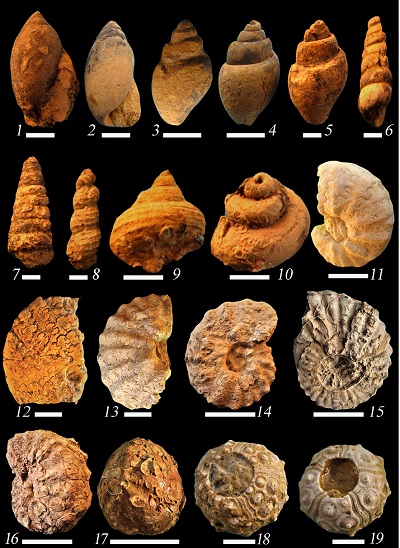 |
| Figure 6. Gastropods, cephalopods and echinoids. 1, 2, Liopeplum? sp.; 3-5, Columbellina sp.; 6, 7, Cryptaulax? sp.; 8, Turritella? sp.; 9, 10, Pleurotomaria sp.; 11, Knemiceras duberterti; 12, Sphenodiscus sp.; 13-16, Knemiceras persicum; 17, Serpulid polychaete worms and osteroids attached to the echinoid; 18, 19, Dorocidaris taouzensis. Scale bars = 1 cm. |
The mollusk fauna represents a shallow marine infaunal, epifaunal and pelagic species. The best-preserved mollusks are those epifaunal, filter-feeding ostreoids and suggest an environment rich in nutrients, possibly by influence of nearby fluvial source. However, some bivalves (Figure 7.4-7.6) show serpulid polychaete worms attached to the interior of the shells, suggesting that the ostreoids were dead and disarticulated or the shell was dissolved, leaving the steinkern to be colonized by the worms (Figure 7.4).
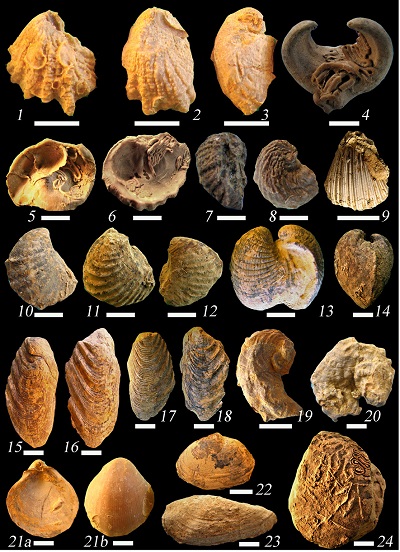 |
| Figure 7. Bivalves. 1-3, 5, 6, Ceratostreon flabellatum; 4, Cardium? sp., 7, 8, Exogyra (Costagyra) olisiponensis; 9, Neithea (Neithea) quinquecostata; 10-12, Trigonia sp.; 13, Buchia? sp.; 14, Cardium? sp.; 15-18, Inoceramus sp.; 19, 20, Pseudogyra sp.; 21a, 21b, Ontaria? sp.; 22, Nucula? sp.; 23, Pleuromia? sp., 24, Bivalvia. Scale bars = 1 cm. |
4.2. CRUSTACEA
Several, nearly complete carapaces of the raninoid crab Notopocorystes xizangensis (Figure 8) were collected from the study area, along with numerous small fragments of pereiopods of this species and callianassoid speecimens. N. xizangensis was first reported from Aptian–Albian beds of the Tackna Formation of the Lhsa region, Xizang, Tibet (Wang, 1981). The second report was from Albian strata of the Albian Kolah Qazi section-Beudanticeras shale, Central Iran (Yazdi et al., 2009). The here reported specimens show the same morphological features and small size, characteristic of this species of the genus Notopocorystes. In fact, the species seem to be more abundant in this new locality and specimes are more complete, showing mainly dorsal morphology, but some preserved also the venral región and coxae. Its abundance in Iran indicate favorable paleoecological conditions for the development and distribution of this species in the warm, shallow marine areas of the Albian in Central Iran.
 |
| Figure 8. Crustacea. 1-14, Notopocorystes xizangensis; 1, 2, dorsal and ventral views; 3-14, dorsal views. Sacel bars = 1 cm. |
4.3. ECHINOIDEA
Two specimens of regular echinoids belong to Dorocidaris taouzensis Lambert 1933 (Figure 6.17, 6.18). The test of the specimens is well-preserved, suggesting no significant transport from hard surfaces where these echinoids feed on algae and organic matter (Benyoucef et al., 2012; Gholamalian et al., 2016).
- Discussion and Results
Bulot et al. (2010), Kennedy et al. (2009), Reboulet et al. (2011), Asadi et al. (2015, 2016) and Raisossadat et al. (2021) studied the ammonite species Knemiceras dubertreti and K. persicum from lower to upper Albian of Iran. Species K. dubertreti and K. persicum of Sample k3, k7 and k8, can be attributed to the Albian and corresponds to the zones 1-4 of Parvaneh-Nejad Shirazi et al., 2011). Maghfouri-Moghaddam et al. (2016) described assemblages of gastropods and bivalves of the Kazhdumi Formation in Naqsh-Rustam section N Fras province and attribiuted the assemblage to the upper Albian-lower Cenomanian, the bivalve species of their study Ceratostreon flabellatum, Nucula sp., Inoceramus sp., Neithea sp., are also presented at the Firuzabad and Fasakhod sections.
Benyoucef et al. (2012) present the echinoid species Dorocidaris taouzensis Lambert, 1933 from the Cenomanian of Algeria. Gholamalian et al. (2016) reported this species from the sample N10 of the Cenomanian interval at the upper part of the Kazhdumi Formation in Gurgen section of Fars province (SW Iran). Dorocidaris taouzensis belongs to the Sample k10 at the upper part of the Firuzabad section and indicates the Cenomanian age to unit 9 of the interval corresponding to the zones 5 of Parvaneh-Nejad Shirazi et al. (2011).
With respect to life habits of bivalves and gastropods, stationary epifauna organisms prevail, followed by epifaunal mobile, deep-infaunal is rare and there is no epifaunal cemented, this indicates the existence of soft substrate (Ayoub-Hannaa and Fürsich, 2012). The absence of large and heavy gastropods and bivalves indicates instability of the substrate, according to feeding habits, suspension feeders dominate strongly the association followed by grazer. Deposits feeder is rare, this means that water energy was medium, low enough for organic matter, nutrients for deposit-feeders, to accumulate in the sediment, but sufficiently high for suspension-feeder. The studied taxa are similar to other assemblages of the western Tethys that show the existence of a possible passage which was open during this time interval Abdelhamid and El Qot, 2002 (Egypt).
- Conclusion
Albian-Cenomaian gastropods, ammonites, bivalves, crustaceans and echinoids are reported for the first time in the Kazhdumi Formation of Firuzabad and (and equivalent deposits) Fasakhod sections. The co-occurrence of epifaunal mobile and shallow infaunal gastropods and bivalves indicates that the substrate was soft during this time. Also, the presence of deposit-feeders and suspension feeders in the association reflects a medium water energy. The water energy was low enough for organic matter, the food for deposit-feeders, to accumulate in the sediment, but sufficiently high for suspension feeder. The studied taxa are similar to other assemblages of the western Tethys that show the existence of a possible passage, which was open during this time interval.
Acknowledgements
The authors are grateful to the Vice Chancellor for Research and Technology at University of Isfahan for financial and logistic support.
Contributions of authors
Babak Sedghi: fieldwork, basic stratigraphic data. Ali Bahrami: conceptualization, writing of original manuscript, figures design. Mehdi Yazdi: Fieldwork, data interpretation writing of original manuscript. Francisco J. Vega: partial paleontological identification and interpretation, correction and edition of the manuscript.
Financing
The Vice Chancellor for Research and Technology at University of Isfahan is acknowledged for financing granted to the PhD project of the first author.
Conflicts of interest
The authors declare no conflict of interest.
References
Afghah, M., Motamed, A., Shokrollahi-Allaf, A., 2007, Study of microfacies and sedimentary environments of Kazhdumi Formation northeast Shiraz: Journal of Applied Geology, 3, 23–32.
Afghah, M., Shaabanpour-Haghighi, A., 2014, Aptian biostratigraphy in south Zagros Basin: Geoscience Frontiers, 5(2), 277–288. https://doi.org/10.1016/j.gsf.2013.07.001
Afghah, M., Parvaneh-Nejad-Shirazi, M., Keshavarzi, M., 2020, Biostratigraphy of the Kazhdumi Formation (Albian), northeast of Shiraz, Zagros Basin (SW of Iran): Carbonates and Evaporites, 35, 103. https://doi.org/10.1007/s13146-020-00635-z
Ahmadi-Khalaji, A., Esmaeily, D., Valizadeh, M.V., Rahimpour-Bonab, H., 2007, Petrology and geochemistry of the granitoid complex of Boroujerd, Sanandaj-Sirjan Zone, Western Iran: Journal of Asian Earth Sciences, 29(5-6), 859–877. https://doi.org/10.1016/j.jseaes.2006.06.005
Alavi, M., 2004, Regional stratigraphy of the Zagros foldthrust belt of Iran and its proforeland evolution: American Journal of Science, 304(1), 1–20. https://doi.org/10.2475/ajs.304.1.1
Amirshahkarami, M., Vaziri-Moghadam, H., 2000, Biostratigraphy of Inoceramus Limestone in Kolah-Qazi area: Abstracts, 4th Symposium of Geological Survey of Iran, 89–90.
Amirshahkarami, M., 1998, Biostratigraphy and Palaeobiogeography of Cretaceous (Albian–Torunian) in Kolah-Qazi area (South–Southeast of Isfahan): Iran, University of Isfahan, MS thesis (in Persian), 139 p.
Arampour, A., Afghah, M., Parvaneh-Nejad-Shirazi, M., 2021, Biostratigraphy and depositional architecture of the Kazhdumi formation (Aptian-Albian) in the Izeh zone, Zagros mountains, SW Iran: Iranian Journal of Earth Sciences, 13(3), 223–237. https://doi.org/10.30495/ijes.2021.682869
Asadi, A., Fard, M., Vaziri, S. H., Rad, M., 2015, Systematic Palaeontology Albian Ammonites of Kazhdumi Formation in Khartang Section, East of Bushehr (Zagros Zone): Indian Journal of Natural Sciences, 5, 8290-8300.
Asadi, A., Majidi Fard, M. R., Vazirii, S. H.,Yousefi Rad, M., 2016, Albian ammonites of the Kazhdumi Formation in the Nar section, east of Bushehr (Zagros zone): Scientific Quarterly Journal of Geosciences, 25(98), 199-212. https://doi.org/10.22071/gsj.2016.41205
Ayoub-Hannaa, W. S., Fürsich, F. T., 2012, Palaeoecology and environmental significance of benthic associations from the Cenomanian-Turonian of eastern Sinai, Egypt: Beringeria, 42, 93-138.
Benyoucef, M., Meister, C., Bensalah, M., Malti, F. Z., 2012, La plateforme préafricaine (Cénomanien supérieur-Turonien inférieur) dans la région de Béchar (Algérie): stratigraphie, paléoenvironnements et signification paléobiogéographique: Revue de Paléobiologie, 31(1), 205-218.
Barber, D.E., Stockli, D.F., Horton, B.K., Koshnaw, R.I., 2018, Cenozoic exhumation and foreland basin evolution of the Zagros orogen during the Arabia-Eurasia collision, western Iran: Tectonics 37, 4396–4420. https://doi.org/10.1029/2018TC005328
Berberian, F., Muir, I.D., Pankhurst, R.J., Berberian, M., 1982, Late Cretaceous and early Miocene Andean-type plutonic activity in northern Makran and central Iran: Journal of the Geological Society, London, 139, 605–614. https://doi.org/10.1144/gsjgs.139.5.0605
Blanc, E.J., Allen, M.B., Inger, S., Hassani, H., 2003, Structural styles in the Zagros simple folded zone, Iran: Journal of the Geological Society, 160, 401-412. https://doi.org/10.1144/0016-764902-110
Bulot, L.G., 2010, Appendix. Systematic palaeontology of Aptian and Albian ammonites from Southwest Iran, in Vincent, B., F.S.P. van Buchem, L.G., Bulot, A., Immenhauser, M., Caron, D., Baghbani, Huc, A.Y. (eds.), Crabonisotope stratigraphy, biostratigraphy and organic matter distribution in the Aptian – Lower Albian successions of southwest Iran (Dariyan and Kazhdumi Formations): Geo Arabia special publication, 4(1), 167–195.
Byrne, D.E., Sykes, L.R., Davis, D.M., 1992, Great thrust earthquakes and aseismic slip along the plate boundary of the Makran subduction zone: Journal of Geophysical Research, Solid Earth, 97(B1), 449–478. https://doi.org/10.1029/91jb02165
Dewey, J.F., Pitman, W.C. III, Ryan, W.B.F. Bonnin, J., 1973, Plate tectonics and the evolution of the alpine system: Geological Society of America Bulletin, 84(10), 3137–3180. https://doi.org/10.1130/0016-7606(1973)84<3137:ptateo>2.0.co;2
Eftekharnejad, J., 1981, Tectonic division of Iran with respect to sedimentary basins: Journal of Iranian Petroleum Society, 82, 19–28.
Falcon, N.L., 1967, The geology of the northeast margin of the Arabian basement shield: Advancement of Science, 24, 31–42.
Ghasemi, A., Talbot, C., 2006, A new tectonic scenario for the Sanandaj–Sirjan Zone (Iran): Journal of Asian Earth Science, 26(6), 683–693. https://doi.org/10.1016/j.jseaes.2005.01.003
Ghassemi, M.R., Aghanabti, A., Saeidi, A., 2023, Orogenic and epeirogenic events in Iran: Scientific Quarterly Journal, Geosciences, 33(1), 87-106. https://doi.org/10.22071/gsj.2022.324032.1970
Gholamalian, H., Ahmadi, T., Hayrapatian, V., Vaziri, M., Dastanpour, M., 2016, Restos microscópicos de peces del Devónico tardío-Carbonífero temprano de Kerman: Revista Científica Trimestral de Ciencias de la Tierra, 25(100), 131-142.
Ghorbani, M., 2019, Lithostratigraphy of Iran: Dordrecht, Springer, 296 p. https://doi.org/10.1007/978-3-030-04963-8
Jackson, J.A., McKenzie, D., 1984, Active tectonics of the Alpine-Himalayan Belt between western Turkey and Pakistan: Geophysical Journal of the Royal Astronomical Society, 77, 185–264. https://doi.org/10.1111/j.1365-246x.1984.tb01931.x
James, G.A., Wynd, J.G., 1965, Stratigraphic nomenclature of Iranian Oil Consortium Agreement Area: American Association of Petroleum Geologists, Bulletin, 49, 2182–2245. https://doi.org/10.1306/a663388a-16c0-11d7-8645000102c1865d
Kalantari, A., 1976, Microbiostratigraphy of Sarvestan Area, (SW of Iran): National Iranian Oil Company, Geological Laboratories Publications, Tehran, 128 p.
Kalantari, A.,1981, Iranian Fossils: National Iranian Oil Company, Tehran, 48 p.
Kennedy, W.J., Reyment, R.A., Mac Leod, N., Krieger, J., 2009, Species discrimination in the Lower Cretaceous (Albian) ammonite genus (Knemiceras von Buch 1848): Palaeontographica, Beiträge zur naturgeschichte der vorzeit, Abteilung A: Paläozoologie- Stratigraphie, 290(1-3), 1–63. https://doi.org/10.1127/pala/290/2009/1
Maghfouri-Moghaddam, I., Shams, P., Parvaneh-Nejad-Shirazi, M., 2016, Systematic of Albian - Cenomanian Gastropods and Bivalves from the Kazhdumi Formation, Zagros Basin: Journal of Sciences, Islamic Republic of Iran, 27(3), 237–252.
Mannani, M., Yazdi, M., 2009, Late Triassic and Early Cretaceous sedimentary sequences of the northern Isfahan Province (Central Iran): stratigraphy and paleoenvironments: Boletín de la Sociedad Geológica Mexicana, 61, 367–374. https://doi.org/10.18268/bsgm2009v61n3a6
McCall, G.J.H., 2002, A summary of the geology of the Iranian Makran. – In: Clift, P.D., Kroon, F.D., Gaedecke, C., Craig, J. (eds.), The tectonic and climatic evolution of the Arabian Sea Region: Special Publication of the Geological Society, 195, 147–204. https://doi.org/10.1144/gsl.sp.2002.195.01.10
Mirnejad, H., Lalonde, A.E., Obeid, M., Hassanzadeh, J., 2013, Geochemistry and petrogenesis of Mashhad granitoids: An insight into the geodynamic history of the Paleo-Tethys in northeast of Iran: Lithos, 170–171, 105–116. https://doi.org/10.1016/j.lithos.2013.03.003
Motiei, H., 1992, Zagros stratigraphy: Geological Survey of Iran, Iran, 536 p.
Motiei, H., 1993, Treatise on the geology of Iran, Stratigraphy of Zagros: Tehran, Geological Survey of Iran, 497 p. (in Persian).
Radfar, M.H., 1998, Helminth parasites of Greasy grouper (Epinephelus tavina) in Persian Gulf: Tehran, University of Tehran, Doctoral thesis, 213 p.
Raisossadat, S. N., Latil, J. L., Hamdani, H., Jaillard, E., Amiribakhtiar, H., 2021, The Kazhdumi Formation (Lower Cretaceous, upper Aptian–upper Albian) in the Zagros Basin, Iran: Cretaceous Research, 127, 104920. https://doi.org/10.1016/j.cretres.2021.104920
Richards, J.P., Wilkinson, D., Ullrich, T., 2006, Geology of the Sari Gunay epithermal gold deposit, northwest Iran: Economic Geology, 101(8), 1455–1496. https://doi.org/10.2113/gsecongeo.101.8.1455
Reboulet, S., Rawson, P.F., Moreno-Bedmar, J.A., Aguirre-Urreta, M.B., Barragán R., Bogomolov, Y., Company, M., González-Arreola, C., Idakieva, Stoyanova,V., Lukeneder, A., Matrion, B., Mitta, V., Randrianaly, H., Vasicek, Z., Baraboshkin, E.J., Bert, D., Bersac, S., Bogdanova, T.N., Bulot, L.G., Latil, J.L., Mikhailova, I.A., Ropolo, P., Szives, O., 2011, Report on the 4th International Meeting of the IUGS Lower Cretaceous Ammonite Working Group, the “Kilian Group” (Dijon, France, 30th August, 2010: Cretaceous Research 32, 786–793.
Sahandi, M.R., Soheily, M., Sadeghi, M., Delavar, S.T., Jafari-Rad, A., 2002, 1:1,000,000 Geological Map of Iran: Tehran, Geological Survey of Iran.
Saidi, A., Brunet, M.F., Ricou, L.E., 1997, Continental accretion of the Iran Block to Eurasia as seen from Late Paleozoic to Early Cretaceous subsidence curves: Geodinamica Acta, 10, 189–208. https://doi.org/10.1080/09853111.1997.11105302
Salehi, M.A., Tadayon, M., 2019, Early Cretaceous sedimentary provenance and structural evolution of the central Sanandaj–Sirjan Zone, Iran: implications for palaeogeographic reconstructions of the northern Neo-Tethyan margin: International Geology Review, 62(11), 1359-1386. https://doi.org/10.1080/00206814.2019.1647120
Sedaghat, M.E., Dabaghian-Nezhad, A., 1996, Geological map of the Farrashband, scale: 1:100,000: Tehran, Iran, Geological Survey of Iran.
Sengore, A.M.C., 1984, The Cimmeride orogenic system and the tectonics of Eurasia: Geological Society of America, Special Papers, 195, 1–82. https://doi.org/10.1130/spe195-p1
Sengore, A.M.C., 1990, A new model for the late Palaeozoic– Mesozoic tectonic evolution of Iran and implications for Oman, in Robertson, A.H.F., Searle, M.P., Ries, A.C., (eds.), The geology and tectonics of the Oman region: Geological Society of London, Special Publications, 49, 797–831. https://doi.org/10.1144/gsl.sp.1992.049.01.49
Seyed-Emami, K., Brants, A., Bozorgnia, F., 1971, Stratigraphy of the Cretaceous rocks southeast of Esfahan: Geological Survey of Iran, 20, 5–27.
Shahabpour, J., 2005, Tectonic evolution of the orogenic belt in the region located between Kerman and Neyriz: Journal of Asian Earth Sciences, 24(4), 405–417. https://doi.org/10.1016/j.jseaes.2003.11.007
Shirazi, P. N., Bahrami, M., Rezaee, B., Gharamani, S., 2011, Microbiostratigraphy of Kazhdumi formation in the Northwestern Shiraz (Southwest Iran) on the basis of foraminifera and calcareous algae: Acta Geologica Sinica‐English Edition, 85(4), 777-783. https://doi.org/10.1111/j.1755-6724.2011.00483.x
Soleimani, B., 2009, Paleoclimate reconstruction during Pabdeh, Gurpi, Kazhdumi and Gadvan formations (Cretaceous-Tertiary) based on clay mineral distribution: World Academy of Science Engineering and Technology, 3(3), 351–355. https://doi.org/10.5281/zenodo.1085417
Soleimani, B., Monjezi, K., Maleki, S., 2014, Microfacies, diagenetic and depositional environment of Kazhdumi Formation (Aptian-Albian), Dezful Embayment Zagros NW Iran: Journal of Geosciences, 3(3), 1–10. https://doi.org/10.4172/2329-6755.1000154
Stampfli, G., Marcoux, J., Baud, A., 1991, Tethyan margins in space and time: Palaeogeography, Palaeoclimatology, Palaeoecology, 87(1-4), 373–409. https://doi.org/10.1016/0031-0182(91)90142-E
Stocklin, J., 1968, Structural history and tectonics of Iran: a review: The American Association of Petroleum Geologists, Bulletin, 52(7), 1229–1258. https://doi.org/10.1306/5d25c4a5-16c1-11d7-8645000102c1865d
Stocklin, J., Nabavi, M.H., 1973, Tectonic map of Iran 1:2500000: Geological Survey of Iran.
Stocklin, J., Setudehina, A., 1991, Stratigraphic lexicon of Iran: Geological Survey of Iran Report, 18, 376p.
Walker, R., Jackson, J., 2004, Active tectonics and late Cenozoic strain distribution in central and eastern Iran: Tectonics, 23(5), TC5010.https://doi.org/10.1029/2003TC001529
Wang, Y., 1981, Late Lower Cretaceous fossil Decapoda from Lhasa Region, Xizang, in Qinghai-Xizang, P., (comp.), The Scientific Expedition to the 1981, Palaeontology of Xizang (Book III): Beijing, Science Press, 349–354.
Yazdi, M., Bahrami, A., Vega, F.J., 2009, Albian decapod Crustacea from Southeast Isfahan, Central Iran-Kolah-Qazi area: Bulletin of the Mizunami Fossil Museum, 35, 71–77.
Peer Reviewing under the responsibility of Universidad Nacional Autónoma de México.
This is an open access article under the CC BY-NC-SA license(https://creativecommons.org/licenses/by-nc-sa/4.0/)

